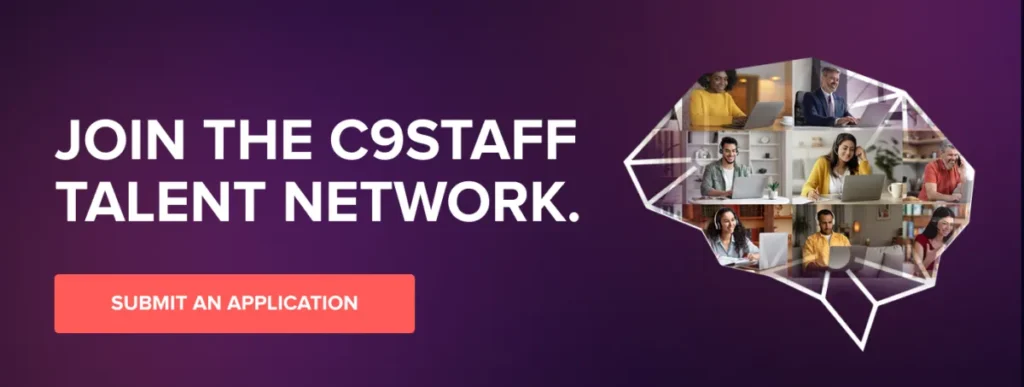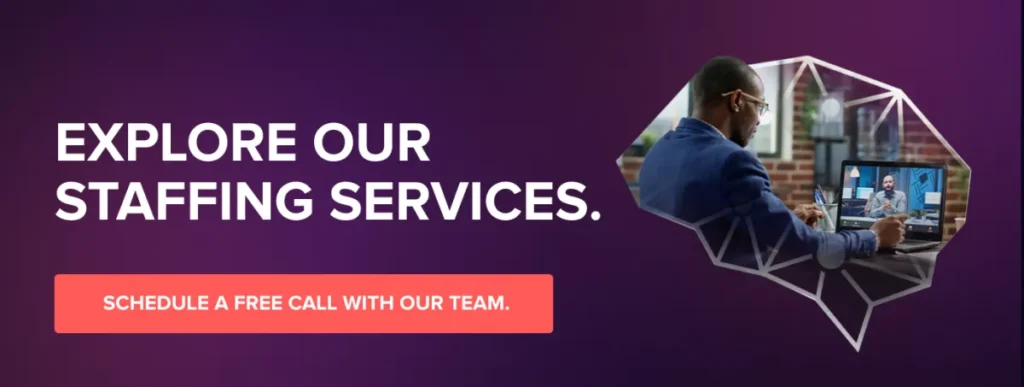Introduction

Welcome to your gateway into the dynamic world of instructional design—a field where art meets science to create transformative educational experiences. Whether you’re looking to hire the perfect instructional designer or aspiring to become one, understanding the intricacies of this role is crucial in today’s multifaceted educational landscape.
For employers focused on crafting the most effective and comprehensive instructional designer job descriptions, we offer an invaluable resource. If your goal is to find the best template that serves as a solid foundation for your own hiring specifications, look no further. Click the link below for direct access to our complimentary Instructional Designer Job Description template. This document embodies the fundamental principles and best practices of C9Staff’s proven hiring methodology, ensuring you attract top talent by setting clear expectations and requirements. Equip your hiring team with the tools they need to succeed by downloading our expertly crafted template today.
INSTRUCTIONAL DESIGNER JOB DESCRIPTION TEMPLATE

At its core, an instructional designer is not just a teacher or a technologist, but a strategist who crafts compelling learning journeys. Across sectors—be it the rigorous academic realms of education, the fast-paced innovation of the corporate world, or the structured environments of government—instructional designers are the architects behind effective education. They tailor learning experiences not only to educate but to engage and empower learners, ensuring that knowledge is not just received but retained and applied.
In education, these professionals are pivotal in developing curriculums that accommodate diverse learning styles while adhering to educational standards. In the corporate sphere, they design training programs that are crucial for upskilling employees and maintaining competitive edges. Government agencies rely on instructional designers to communicate and implement policies effectively, ensuring that public service employees are well-informed and proficient.
As you dive into this guide, you will discover a comprehensive exploration of what makes an effective instructional designer and how these roles differ significantly yet fundamentally connect across various industries. This article promises to arm employers with the knowledge to craft detailed, appealing job descriptions that attract top talent. Simultaneously, aspiring instructional designers will gain insights into tailoring their skills and resumes to meet the demands of this evolving field.
So, whether you are drafting your next job posting or shaping your career path, this guide is your companion in understanding and leveraging the power of instructional design to achieve remarkable educational outcomes. Stay tuned as we unpack the skills, strategies, and secrets that define success in the realm of instructional design.
What is Instructional Design?

Instructional design is a systematic process that applies educational and psychological principles to the creation of effective learning environments and materials. At its core, it focuses on the learner’s journey, tailoring educational experiences that enhance understanding and retention. This field strategically merges technology, pedagogy, and curriculum development to ensure that educational goals are met effectively and efficiently.
The scope of instructional design is vast, interfacing with digital technologies to deliver engaging content across various platforms—from traditional classrooms to online courses and corporate training workshops. As education evolves, the role of instructional designers becomes increasingly crucial, ensuring that teaching methods keep pace with technological advancements and educational needs.
Tracing its roots back to World War II, instructional design emerged as a critical tool for military training. Psychologists and educators collaborated to develop training materials that would rapidly and effectively prepare troops. Over the decades, this discipline has expanded beyond the military, influencing public education, higher education, and corporate training. Significant milestones include the introduction of Bloom’s Taxonomy in the 1950s, which provided a systematic classification of learning objectives, and the later incorporation of digital tools in the 1990s, which transformed how educational content is delivered and consumed.
Three core principles of instructional design anchor its practice:
1. Learner-Centered Design: This principle places the learner at the forefront, advocating for designs that are tailored to the needs, backgrounds, and experiences of the audience. It encourages active engagement and interaction, making learning more relevant and impactful.
2. Systematic Design of Learning Activities: Instructional design follows a meticulous, planned approach that includes analysis, design, development, implementation, and evaluation (ADDIE model). This ensures that educational programs are thoughtfully crafted to meet specific learning outcomes.
3. Importance of Assessment for Learning: Continuous assessment is integral to instructional design. It provides critical feedback that shapes both teaching strategies and learning materials, ensuring that they are effective in meeting educational objectives.
By embracing these principles, instructional designers play a pivotal role in crafting educational experiences that are not only informative but transformative. As you continue to explore this guide, consider how these foundational concepts apply to various roles within the field, influencing responsibilities, required skills, and future directions in instructional design. Whether you are an employer drafting a job description or a professional seeking to enter this field, understanding these principles is crucial for success in instructional design.
Key Responsibilities of an Instructional Designer

Instructional designers are the unsung heroes behind the scenes of effective learning and development across various sectors. They wield a unique blend of skills to enhance education and training, ensuring that learners not only absorb but apply knowledge effectively. Let’s dive into the multifaceted role of these pivotal professionals, explore how their responsibilities vary across different industries, and examine some real-world impacts of their work.
Typical Responsibilities of Instructional Designers
At its core, the role of an instructional designer involves developing educational programs that are both effective and efficient. This typically includes:
Curriculum Development: Designing course outlines and content that align with learning objectives and standards.
Educational Technology Integration: Implementing and managing learning management systems (LMS) and other educational technologies to enhance learning experiences.
Learner Assessment: Creating and administering assessments to evaluate learner progress and instructional effectiveness.
Instructional Strategies: Choosing appropriate instructional methods and tactics tailored to the audience and content.
Feedback Incorporation: Using learner and stakeholder feedback to refine and optimize educational offerings.
Industry-Specific Roles and Challenges
While the core skills of instructional design are transferable, the application and emphasis can vary significantly by industry:
Corporate Settings: Here, instructional designers often focus on training employees for specific job roles or technologies. The challenge lies in aligning learning objectives with business goals and ensuring ROI through enhanced employee performance. For example, a designer at a tech company might develop a series of web-based modules for software training that employees can access on-demand, significantly reducing downtime and facilitating continuous learning.
Educational Institutions: In schools and universities, instructional designers work closely with faculty to develop curricula that meet academic standards and cater to diverse student needs. The challenge here is to integrate innovative teaching techniques that engage students from varied academic backgrounds and learning styles. For instance, an instructional designer might collaborate with teachers to create interactive, multimedia-rich content that makes complex scientific concepts accessible and engaging for high school students.
Government Agencies: Instructional designers in this sector often deal with large-scale training programs that need to comply with strict standards and regulations. The objective is often to enhance public service efficiency or to provide upskilling opportunities. A notable project might include the development of an online training program for public health officials on emergency response protocols, which was crucial during the COVID-19 pandemic.
Real-World Impact of Instructional Design
Consider the case of a corporate instructional designer who developed a comprehensive onboarding program for a multinational corporation. By integrating interactive simulations and real-time feedback mechanisms, the program reduced the average onboarding time by 30%, significantly improving time-to-productivity ratios for new hires and demonstrating a clear return on investment.
In an educational setting, an instructional designer revamped an online college course on environmental science by incorporating virtual field trips and gamified quizzes. Student engagement levels soared, and course completion rates increased by 40%, illustrating the profound impact of well-designed instructional content.
Required Skills and Competencies

Get on a career in instructional design demands a diverse set of skills and competencies, ranging from foundational knowledge to advanced technical abilities. Whether you’re just starting out or aiming to elevate your expertise, understanding these essential skills will not only make you a competent instructional designer but will also set you apart in the competitive job market.
Fundamental Skills for Instructional Designers
Effective Communication: As an instructional designer, your ability to articulate ideas clearly and collaborate with subject matter experts, educators, and learners is paramount. This includes proficiency in writing clear instructional texts and the ability to communicate complex concepts effectively.
Project Management: Managing timelines, resources, and team dynamics is critical. You’ll often find yourself juggling multiple projects, requiring an adept understanding of project management principles to keep everything on track and within budget.
Understanding of Learning Theories: A solid grasp of pedagogical theories such as constructivism, behaviorism, and cognitivism is essential. These theories provide the foundation for creating effective learning experiences that cater to various learning styles and needs.
Advanced Skills That Differentiate You
Expertise in Advanced Analytics: In today’s data-driven world, having the ability to analyze and interpret learner data can significantly improve the effectiveness of educational materials. Advanced analytics skills allow you to measure learning outcomes and adapt content to meet learner needs more precisely.
Proficiency with Emerging Technologies: Keeping abreast of the latest technologies, such as AI in education, augmented reality, or virtual learning environments, can greatly enhance the learning experiences you create. For instance, AI can be used to personalize learning paths, making your designs more adaptable and impactful.
Specialized Knowledge in Universal Design for Learning (UDL): This set of principles for curriculum development that give all individuals equal opportunities to learn is increasingly important. Mastery of UDL can help ensure that your instructional materials are accessible and beneficial to a wide range of learners, including those with disabilities.
Tools and Technologies Commonly Used
Learning Management Systems (LMS): Familiarity with platforms like Moodle, Blackboard, or Canvas is crucial. These systems are where your instructional designs come to life, enabling the administration, documentation, tracking, reporting, and delivery of educational courses or training programs.
E-Learning Authoring Tools: Tools like Articulate Storyline, Adobe Captivate, and Lectora are indispensable for creating interactive and engaging digital learning materials. These tools allow for the integration of multimedia, assessments, and simulations that enhance learner engagement.
Graphic Design Software: Knowing how to use design software such as Adobe Photoshop, Illustrator, or InDesign can help you create visually appealing learning materials. Good design can significantly impact learner engagement and material comprehensibility.
Top 5 Essential Skills for Modern Instructional Designers: Unlock Your Potential!
Educational and Professional Background
Boarding on a career as an instructional designer offers an exciting opportunity to shape educational experiences across various industries. For those aspiring to this dynamic field, understanding the educational pathways and professional development opportunities that pave the way to success is crucial.
Educational Backgrounds
The journey typically begins with a solid educational foundation. Degrees in education, instructional technology, graphic design, psychology, or communication are highly recommended. These disciplines provide a deep dive into essential learning theories and design principles, equipping you with the cognitive tools needed to craft effective educational experiences. A bachelor’s degree is often sufficient to start, but a master’s degree in instructional design or technology can significantly enhance your prospects, offering deeper insights and specialization in the field.
Professional Certifications
As you move forward, obtaining professional certifications can be a game-changer, enhancing your credibility and marketability. The Certified Professional in Learning and Performance (CPLP) and the Certified Instructional Designer/Developer are particularly valuable. These certifications not only bolster your resume but also ensure you are proficient in the latest instructional methodologies and technologies. They require a combination of experience and examination, validating your expertise to prospective employers.
Continuing Education and Professional Development
Staying current in this rapidly evolving field is imperative. Engaging in continuing education and professional development courses can keep you at the cutting edge of emerging trends such as mobile learning, gamification, or virtual reality. Many professional associations and universities offer workshops, webinars, and courses that cover these new technologies and instructional strategies, helping you remain a competitive and effective designer.
Crafting the Perfect Instructional Designer Job Description (Employers Section)
Crafting an effective job description for an instructional designer is more than just a list of duties and skills; it’s about painting a vivid picture of the role and what it contributes to your organization. This clarity not only attracts the right candidates but also sets the stage for their future success in your company. Here’s how to write a job description that is clear, engaging, and inclusive, ensuring you attract highly qualified professionals who can truly make a difference.
Step 1: Define the Role Clearly
Begin by outlining what the instructional designer will be expected to achieve in your organization. Be specific about how their role contributes to the broader educational or training goals of your company. For example, you might start with:
“As an instructional designer at [Your Company], you will be tasked with developing engaging learning modules that support our strategic goals of improving employee performance and enhancing continuous learning across all departments. You will collaborate with subject matter experts and the learning and development team to create both online and face-to-face educational experiences.”
Step 2: List Essential Responsibilities
Detail the key responsibilities of the role. Include daily tasks as well as overarching projects they will manage. For instance:
- Design and implement instructional materials and courses, including digital and classroom-based training.
- Apply learning theory/models, benchmarking, and instructional design principles to create top-notch learning experiences.
- Conduct needs assessments and strategic learning assessments to identify the learning needs of the organization.
- Manage the full lifecycle of the learning process, from curriculum planning to implementation and review.
Step 3: Specify Required Qualifications and Skills
Highlight both the necessary educational background and professional skills. Be precise about the technical skills, such as proficiency in specific learning management systems (LMS) like Moodle or Blackboard, and soft skills like critical thinking and effective communication. Mention any required certifications or particular experience in instructional design methodologies.
Example:
“Candidates should hold a Master’s degree in Instructional Design, Educational Technology, or a related field. We value experience with Adobe Captivate and Articulate 360, as well as a proven track record in managing multiple projects in a corporate learning environment.”
Step 4: Use Clear, Engaging, and Inclusive Language
Your language should be accessible and welcoming to attract a diverse applicant pool. Avoid jargon and be mindful of bias-free language. Make the job appealing by focusing on how the role contributes to the organization’s mission and how the organization supports its employees’ professional growth and personal well-being.
Step 5: Highlight Unique Benefits and Opportunities
Candidates are not just looking for a job; they’re looking for an opportunity to grow and contribute to something significant. Mention any unique benefits your company offers, like professional development opportunities, a supportive workplace culture, or innovative projects they will have a chance to lead.
“Join us, and you will not only have the opportunity to lead groundbreaking projects in educational design but also enjoy a flexible work environment, comprehensive health benefits, and extensive professional development programs.”
Step 6: Provide Real Examples
Integrate snippets from effective job descriptions or testimonials about the role from current employees to give candidates real insights into what to expect.
Example snippet: “In my role as an instructional designer here, I’ve had the chance to revolutionize how we deliver training. It’s rewarding to see my work directly enhance our team’s skills and drive our company’s success forward.” – Current Instructional Designer
Final Touch: Call to Action
End with a strong call to action that invites candidates to apply. Make it easy for them to see the next steps if they are excited about the opportunity.
“Are you ready to transform educational experiences? Apply now to become a key player in our team and drive real change in how learning happens at [Your Company].”
By following these steps and maintaining a direct and engaging tone, you will craft a job description that not only fills the position but finds a candidate who will excel and contribute meaningfully to your organization. This is your first step towards harnessing the power of top talent in the instructional design field.
For employers focused on crafting the most effective and comprehensive instructional designer job descriptions, we offer an invaluable resource. If your goal is to find the best template that serves as a solid foundation for your own hiring specifications, look no further. Click the link below for direct access to our complimentary Instructional Designer Job Description template. This document embodies the fundamental principles and best practices of C9Staff’s proven hiring methodology, ensuring you attract top talent by setting clear expectations and requirements. Equip your hiring team with the tools they need to succeed by downloading our expertly crafted template today.
INSTRUCTIONAL DESIGNER JOB DESCRIPTION TEMPLATE

How to Tailor Your Application for an Instructional Design Role (Job Seekers Section)

As you board on the journey to secure a role in instructional design, tailoring your application to highlight your specific skills and experiences is crucial. This strategic approach not only sets you apart from other candidates but also demonstrates your understanding and proficiency in key areas crucial to a successful career in instructional design. Here’s how you can customize your resume, cover letter, and portfolio to make a compelling case for your candidacy.
Resumes and Cover Letters
Customize for the Role: Begin by carefully reading the job description. Identify key skills and experiences the employer emphasizes and tailor your resume to reflect these. Use the exact keywords and phrases from the job posting, as many companies use software to pre-screen applications based on specific criteria.
Highlight Relevant Experience: Showcase your experiences that directly align with the tasks and responsibilities of the position. For example, if the role requires developing e-learning content, highlight any experience you have with learning management systems (LMS), course development software, and any relevant project management experience.
Detail Your Educational Background: Clearly outline your educational qualifications, especially if you have a degree in education, instructional technology, or a related field. Include any specific courses or projects that relate directly to instructional design.
Focus on Achievements: Instead of just listing duties under previous roles, focus on what you accomplished in those roles. Use action verbs and quantify your results when possible, such as “Developed an online curriculum that improved employee learning engagement by 30%.”
Personalize Your Cover Letter: Your cover letter should not only state why you are interested in the role but also provide a narrative form of your key achievements and explain how they align with the job’s requirements. This is your chance to tell a compelling story about your journey and passion for instructional design.
Preparing for Interviews
Anticipate Common Questions: Prepare for common interview questions such as, “Can you describe a successful project you managed?” or “What instructional design models are you familiar with?” Reflect on specific experiences where you applied your knowledge and skills in instructional design to overcome challenges or drive success.
Reflect Your Passion and Knowledge: Employers look for candidates who are not only skilled but also passionate about their work. Be ready to discuss how you stay updated with the latest trends in instructional design and how these influence your work.
Use the STAR Method: When answering questions, structure your responses to reflect the Situation, Task, Action, and Result. This method helps clearly convey your contributions and the impact of your actions.
Showcasing Your Portfolio
Select Relevant Projects: Your portfolio should include a variety of projects that showcase your skills across different aspects of instructional design. Include samples that show your ability to write instructional materials, design courses, and integrate technology effectively.
Organize Thoughtfully: Arrange your portfolio to flow logically, categorizing projects by type or skill set. Include a brief description for each project, highlighting the objective, your role, the tools used, and the outcome.
Digital Presence: In today’s digital age, having an online portfolio can set you apart. Use platforms like LinkedIn or create a personal website where potential employers can easily view your work.
If you’re ready to supercharge your career and land your dream job, C9Staff is here to help. We invite you to submit your resume to our talent acquisition department by clicking the link below. If your qualifications align with our client requirements, we’ll be in touch to explore potential opportunities tailored to your expertise and aspirations. Don’t miss the chance to advance your career—submit your resume today and let us connect you with exciting prospects that match your professional goals.

Unlock Your Future: Master the Path to Becoming an Instructional Designer in 2024
Trends and Future Directions in Instructional Design
As the landscape of education continues to evolve, emerging technologies are dramatically reshaping the role of instructional designers. These professionals are at the forefront of integrating innovative trends such as Virtual Reality (VR), Artificial Intelligence (AI), and mobile learning into educational environments, creating more immersive, personalized, and accessible learning experiences. Understanding these trends is not just beneficial but essential for instructional designers aiming to stay relevant and effective in their roles.
Virtual Reality (VR) in Educational Environments
Virtual Reality has begun to transform traditional learning environments by providing immersive experiences that were once thought impossible. VR allows learners to explore complex environments, practice procedures, and engage in learning activities that enhance understanding and retention without the physical limitations of the classroom setting. For instructional designers, this means an opportunity to create detailed simulations and interactive learning scenarios that can significantly improve learning outcomes. Designers must now understand not only the pedagogical principles but also the technical aspects of VR technology, including software that supports VR learning environments and the hardware most suitable for educational purposes.
Artificial Intelligence (AI) in Education
AI’s impact on education extends from personalized learning algorithms that adapt to individual learner’s needs, to automating administrative tasks, freeing up more time for instructional designers to focus on creative aspects of curriculum development. AI tools can analyze vast amounts of data to identify trends and provide insights into how courses can be improved, which learning elements are most effective, and where students struggle the most. This shift requires instructional designers to develop skills in data analysis and familiarize themselves with AI-driven platforms and tools, ensuring they can effectively integrate AI into their instructional strategies.
The Rise of Mobile Learning
Mobile learning has democratized access to education, allowing learners from various backgrounds to access educational content anytime, anywhere. This trend compels instructional designers to think about mobile-first strategies, designing content that is accessible and effective on smaller screens and for people on the move. This includes understanding responsive design, mobile user experience, and the limitations and capabilities of mobile devices in delivering content.
The Future Role of Instructional Designers
The integration of VR, AI, and mobile learning is not just changing the tools and technologies used in education but is also expanding the skill set required by instructional designers. These professionals must now be adept at leveraging new technologies to create effective learning experiences that meet the needs of a diverse new generation of learners. They need to be continuous learners themselves, constantly updating their knowledge and skills to keep up with technological advancements.
For employers looking to enhance their teams with top-tier instructional design talent, C9Staff offers a comprehensive solution tailored to your specific needs. If you’re ready to explore how we can assist you in sourcing, recruiting, hiring, training, managing, and deploying the ideal instructional designer for your organization, we invite you to schedule a free exploratory call today. During this call, our dedicated account managers will attentively listen to your requirements and provide endorsements for potential candidates at no cost, helping you assess the best talent available at competitive prices. Click the link below to secure a time that suits you and take the first step toward optimizing your hiring strategy with C9Staff.

Conclusion

In this comprehensive exploration of the instructional design landscape, we’ve covered essential terrain from the fundamental role and responsibilities of instructional designers to the advanced skills and emerging trends that are reshaping this dynamic field. Instructional designers sit at the crossroads of technology, education, and innovation, crafting educational experiences that are both engaging and effective. As we’ve seen, the demand for these professionals is influenced by their ability to adapt and evolve in a landscape that is constantly being transformed by new technologies like virtual reality, artificial intelligence, and mobile learning platforms.
To both employers and job seekers within this evolving field: the path forward is paved with continuous learning and adaptation. For employers, understanding the nuanced skills that today’s instructional designers bring to the table goes beyond traditional job descriptions, emphasizing a need for candidates who are not only technically adept but also creatively empowered to navigate and integrate new technologies. For aspiring instructional designers, the journey involves a commitment to lifelong learning, continually updating one’s skill set to stay ahead of technological advances and pedagogical shifts.
The importance of ongoing education and professional development cannot be overstated. Engaging with advanced courses, workshops, and webinars is crucial for keeping pace with the rapid changes in instructional technology and methodology. Whether it’s deepening your knowledge of AI applications in educational settings or mastering the latest in VR content creation, staying informed and proactive is key to both personal career success and organizational advancement.
I encourage all readers to actively engage with learning opportunities that broaden their horizons and enhance their capabilities. Seek out professional development programs that challenge your thinking and expand your skill set. Join webinars that dig into the future of education technology, participate in workshops that offer hands-on experiences with new tools, and enroll in courses that offer fresh perspectives on design and pedagogy.
As you move forward, remember that the field of instructional design is ever-evolving, and success lies in your willingness to embrace change and innovation. Whether you are crafting the next generation of educational experiences or seeking to hire a professional who can lead such initiatives, your proactive engagement in these learning opportunities will prepare you for the future. Stay curious, stay informed, and take the next step in your professional journey with confidence.




